NMBA Standard 2 Reflection: Therapeutic Relationships in Nursing
VerifiedAdded on 2023/06/11
|10
|2123
|396
Report
AI Summary
This report provides a reflective analysis of a nursing scenario using Gibbs' Reflective Cycle, focusing on Standard 2 of the Nursing and Midwifery Board of Australia (NMBA) regarding therapeutic and professional relationships. The reflection describes a nurse-patient interaction, evaluates the nurse's adherence to NMBA standards, analyzes the communication skills employed, and concludes with an action plan to improve therapeutic relationships. Key elements include the nurse's friendly and professional demeanor, effective communication strategies, and respect for patient autonomy. The report emphasizes the importance of therapeutic relationships in achieving positive health outcomes and improving patient satisfaction, referencing various studies that support the use of effective communication and patient-centered care. The action plan outlines steps to foster trust, empathy, and patient empowerment, utilizing frameworks like Peplau's Theory of Interpersonal Relations to enhance the quality of care.
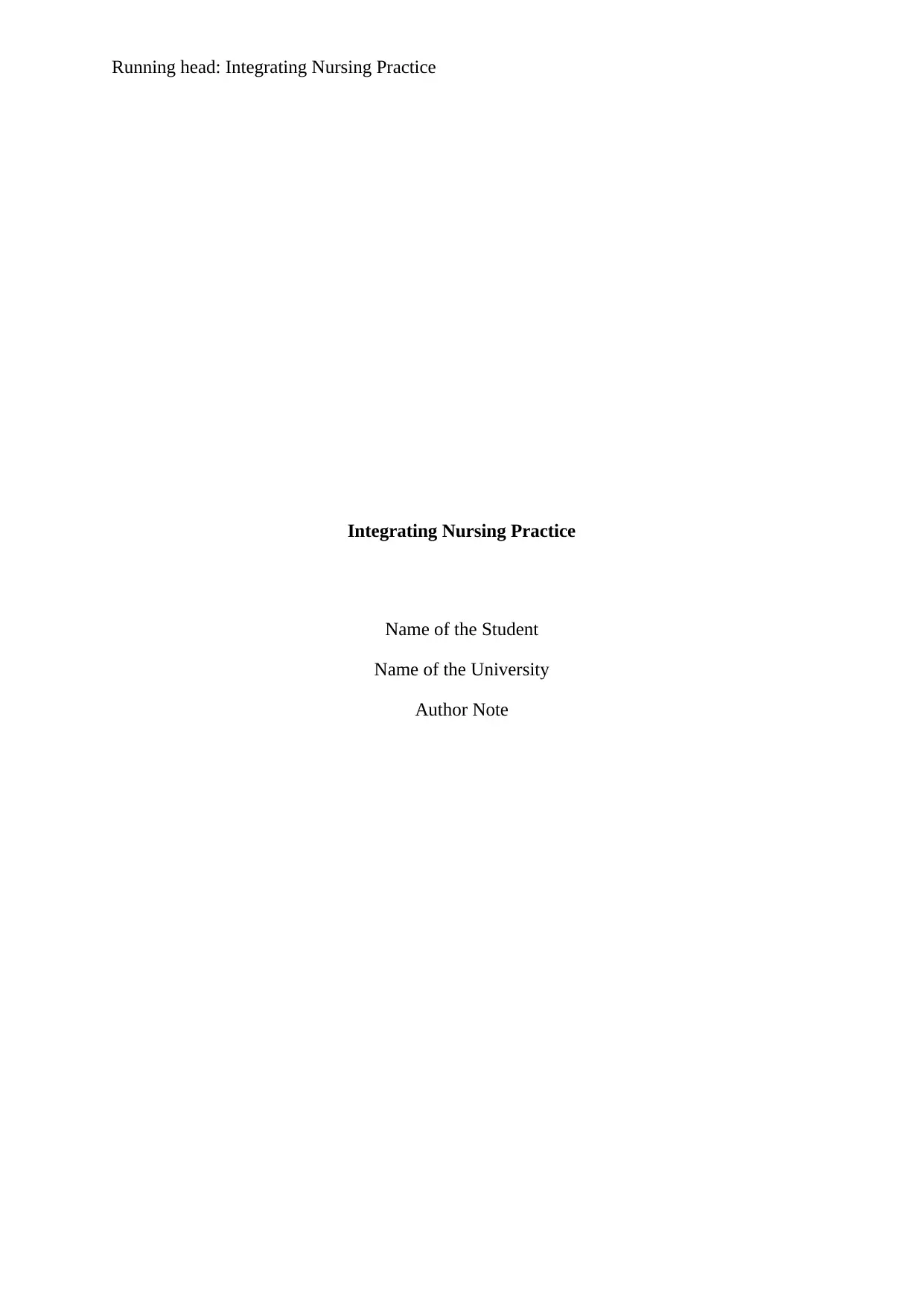
Running head: Integrating Nursing Practice
Integrating Nursing Practice
Name of the Student
Name of the University
Author Note
Integrating Nursing Practice
Name of the Student
Name of the University
Author Note
Paraphrase This Document
Need a fresh take? Get an instant paraphrase of this document with our AI Paraphraser
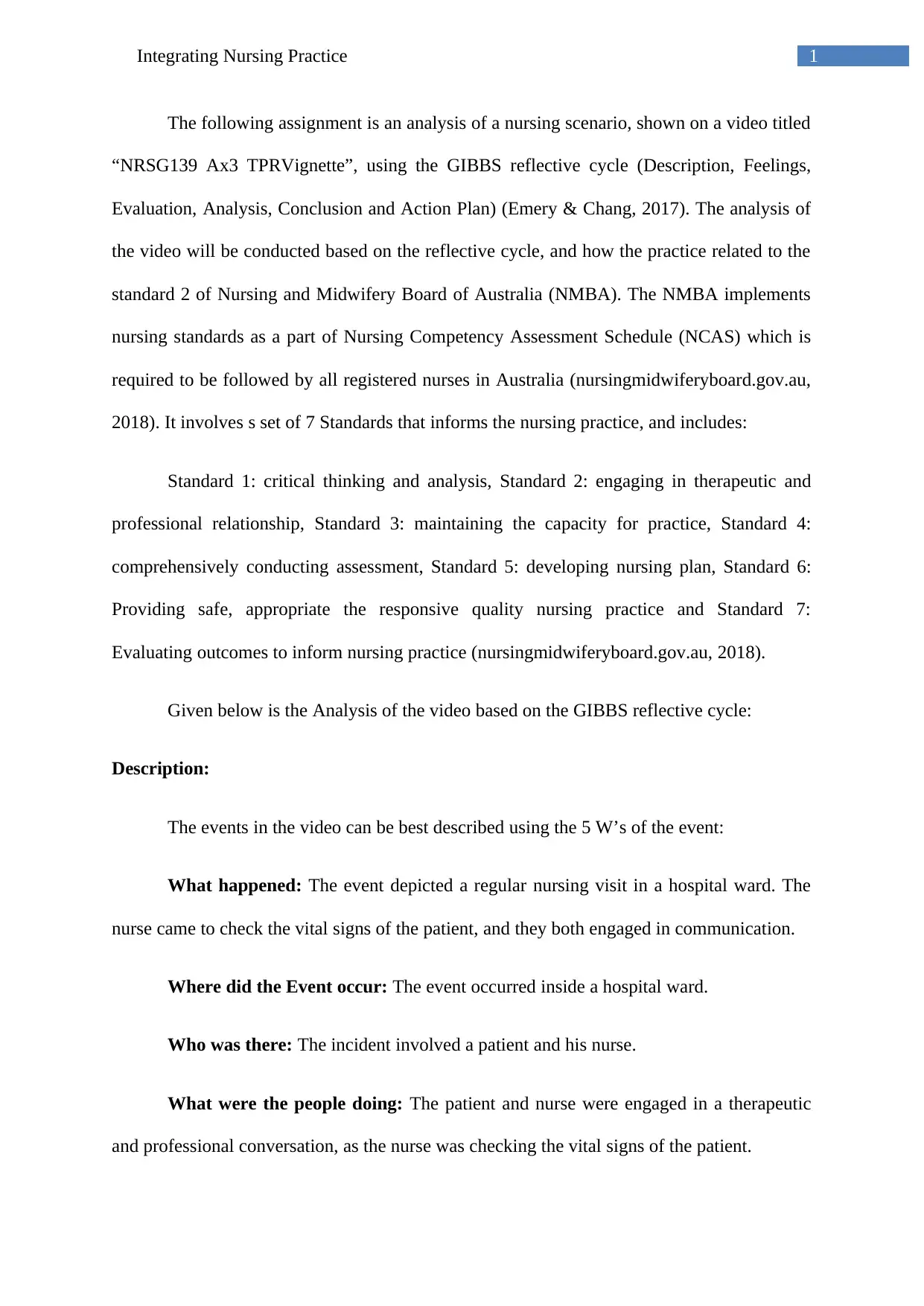
1Integrating Nursing Practice
The following assignment is an analysis of a nursing scenario, shown on a video titled
“NRSG139 Ax3 TPRVignette”, using the GIBBS reflective cycle (Description, Feelings,
Evaluation, Analysis, Conclusion and Action Plan) (Emery & Chang, 2017). The analysis of
the video will be conducted based on the reflective cycle, and how the practice related to the
standard 2 of Nursing and Midwifery Board of Australia (NMBA). The NMBA implements
nursing standards as a part of Nursing Competency Assessment Schedule (NCAS) which is
required to be followed by all registered nurses in Australia (nursingmidwiferyboard.gov.au,
2018). It involves s set of 7 Standards that informs the nursing practice, and includes:
Standard 1: critical thinking and analysis, Standard 2: engaging in therapeutic and
professional relationship, Standard 3: maintaining the capacity for practice, Standard 4:
comprehensively conducting assessment, Standard 5: developing nursing plan, Standard 6:
Providing safe, appropriate the responsive quality nursing practice and Standard 7:
Evaluating outcomes to inform nursing practice (nursingmidwiferyboard.gov.au, 2018).
Given below is the Analysis of the video based on the GIBBS reflective cycle:
Description:
The events in the video can be best described using the 5 W’s of the event:
What happened: The event depicted a regular nursing visit in a hospital ward. The
nurse came to check the vital signs of the patient, and they both engaged in communication.
Where did the Event occur: The event occurred inside a hospital ward.
Who was there: The incident involved a patient and his nurse.
What were the people doing: The patient and nurse were engaged in a therapeutic
and professional conversation, as the nurse was checking the vital signs of the patient.
The following assignment is an analysis of a nursing scenario, shown on a video titled
“NRSG139 Ax3 TPRVignette”, using the GIBBS reflective cycle (Description, Feelings,
Evaluation, Analysis, Conclusion and Action Plan) (Emery & Chang, 2017). The analysis of
the video will be conducted based on the reflective cycle, and how the practice related to the
standard 2 of Nursing and Midwifery Board of Australia (NMBA). The NMBA implements
nursing standards as a part of Nursing Competency Assessment Schedule (NCAS) which is
required to be followed by all registered nurses in Australia (nursingmidwiferyboard.gov.au,
2018). It involves s set of 7 Standards that informs the nursing practice, and includes:
Standard 1: critical thinking and analysis, Standard 2: engaging in therapeutic and
professional relationship, Standard 3: maintaining the capacity for practice, Standard 4:
comprehensively conducting assessment, Standard 5: developing nursing plan, Standard 6:
Providing safe, appropriate the responsive quality nursing practice and Standard 7:
Evaluating outcomes to inform nursing practice (nursingmidwiferyboard.gov.au, 2018).
Given below is the Analysis of the video based on the GIBBS reflective cycle:
Description:
The events in the video can be best described using the 5 W’s of the event:
What happened: The event depicted a regular nursing visit in a hospital ward. The
nurse came to check the vital signs of the patient, and they both engaged in communication.
Where did the Event occur: The event occurred inside a hospital ward.
Who was there: The incident involved a patient and his nurse.
What were the people doing: The patient and nurse were engaged in a therapeutic
and professional conversation, as the nurse was checking the vital signs of the patient.
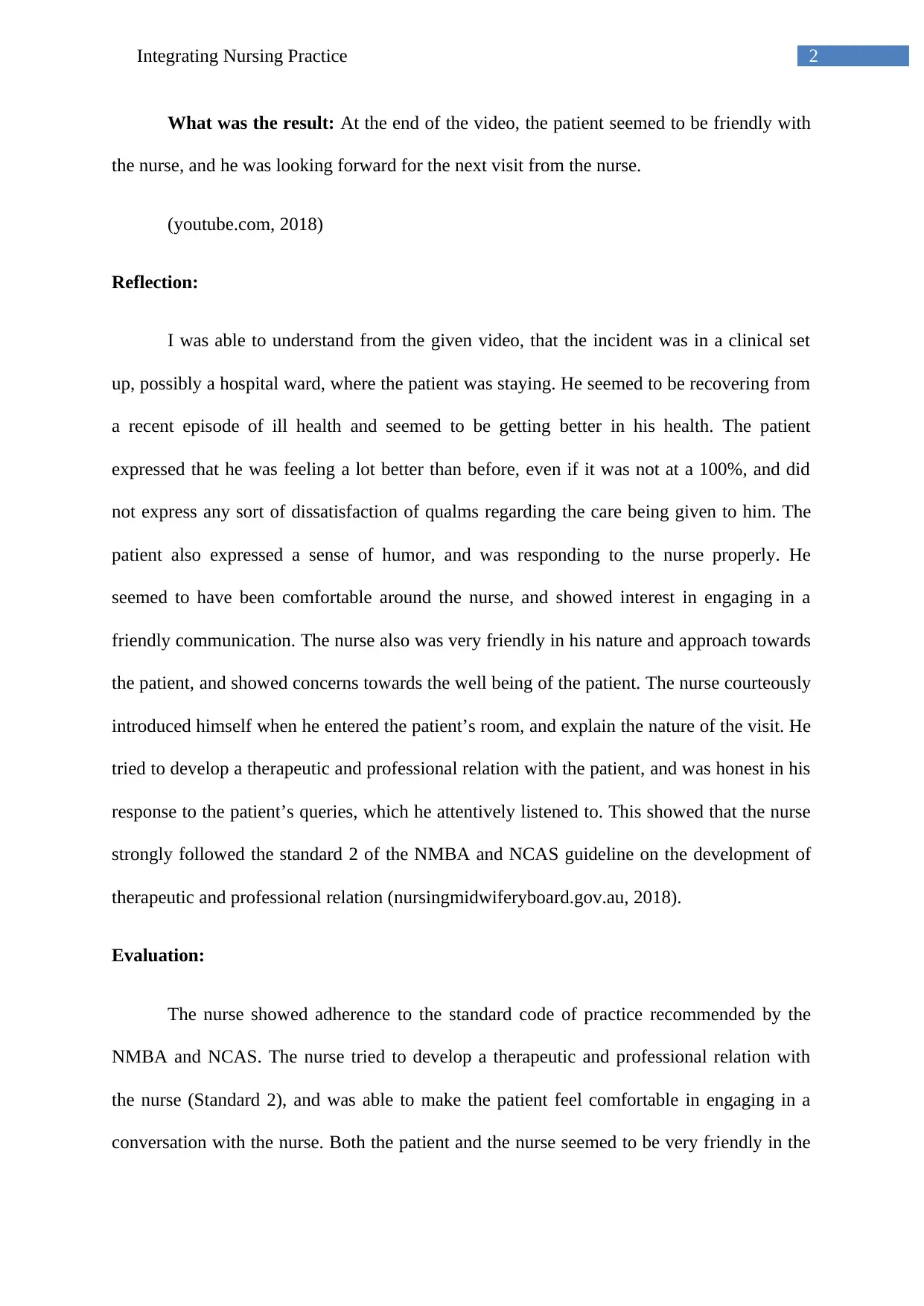
2Integrating Nursing Practice
What was the result: At the end of the video, the patient seemed to be friendly with
the nurse, and he was looking forward for the next visit from the nurse.
(youtube.com, 2018)
Reflection:
I was able to understand from the given video, that the incident was in a clinical set
up, possibly a hospital ward, where the patient was staying. He seemed to be recovering from
a recent episode of ill health and seemed to be getting better in his health. The patient
expressed that he was feeling a lot better than before, even if it was not at a 100%, and did
not express any sort of dissatisfaction of qualms regarding the care being given to him. The
patient also expressed a sense of humor, and was responding to the nurse properly. He
seemed to have been comfortable around the nurse, and showed interest in engaging in a
friendly communication. The nurse also was very friendly in his nature and approach towards
the patient, and showed concerns towards the well being of the patient. The nurse courteously
introduced himself when he entered the patient’s room, and explain the nature of the visit. He
tried to develop a therapeutic and professional relation with the patient, and was honest in his
response to the patient’s queries, which he attentively listened to. This showed that the nurse
strongly followed the standard 2 of the NMBA and NCAS guideline on the development of
therapeutic and professional relation (nursingmidwiferyboard.gov.au, 2018).
Evaluation:
The nurse showed adherence to the standard code of practice recommended by the
NMBA and NCAS. The nurse tried to develop a therapeutic and professional relation with
the nurse (Standard 2), and was able to make the patient feel comfortable in engaging in a
conversation with the nurse. Both the patient and the nurse seemed to be very friendly in the
What was the result: At the end of the video, the patient seemed to be friendly with
the nurse, and he was looking forward for the next visit from the nurse.
(youtube.com, 2018)
Reflection:
I was able to understand from the given video, that the incident was in a clinical set
up, possibly a hospital ward, where the patient was staying. He seemed to be recovering from
a recent episode of ill health and seemed to be getting better in his health. The patient
expressed that he was feeling a lot better than before, even if it was not at a 100%, and did
not express any sort of dissatisfaction of qualms regarding the care being given to him. The
patient also expressed a sense of humor, and was responding to the nurse properly. He
seemed to have been comfortable around the nurse, and showed interest in engaging in a
friendly communication. The nurse also was very friendly in his nature and approach towards
the patient, and showed concerns towards the well being of the patient. The nurse courteously
introduced himself when he entered the patient’s room, and explain the nature of the visit. He
tried to develop a therapeutic and professional relation with the patient, and was honest in his
response to the patient’s queries, which he attentively listened to. This showed that the nurse
strongly followed the standard 2 of the NMBA and NCAS guideline on the development of
therapeutic and professional relation (nursingmidwiferyboard.gov.au, 2018).
Evaluation:
The nurse showed adherence to the standard code of practice recommended by the
NMBA and NCAS. The nurse tried to develop a therapeutic and professional relation with
the nurse (Standard 2), and was able to make the patient feel comfortable in engaging in a
conversation with the nurse. Both the patient and the nurse seemed to be very friendly in the
⊘ This is a preview!⊘
Do you want full access?
Subscribe today to unlock all pages.

Trusted by 1+ million students worldwide

3Integrating Nursing Practice
communication, which showed a positive relation being developed among them. The nurse
also was able to make himself familiar with the patient, how long he was staying in the
hospital, how he felt and gave him confidence that his vital signs were good, and was
indicative of recovery. The nurse provided courage to the patient, by informing him that he
can soon expect to be discharged, and the patient seemed to be happy about it. It was evident
that the nurse was able to instill confidence in the patient, and made the patient feel better.
The comfort level of the patient could be understood by the subtle joke shared and responded
between the two, and of patient expressing that he looked forward for the next visit. The
nurse also exhibited professional qualities, in keeping the patient informed about the
condition, and in addressing the patient’s queries with honesty. The nurse also maintained
eye contact with the patient, and was respectful to him at all times. His information was also
very clear and easy to understand, and he avoided using complicated jargons which could
have confused the patient.
Analysis:
The nurse showed different skills that helped to develop communication with the
patient. His usage of language was appropriate, and his body language proper, the
communication strategies utilized were also very effective, and the attitude as well as
demeanor of the nurse was professional, courteous and respectful. The autonomy and privacy
of the patient was also identified and respected by the nurse. The nurse also paid attention to
the thought processes and opinions of the patient, and thus followed the competencies and
skills needed to develop a therapeutic and professional relation in accordance to standard 2 of
NMBA (nursingmidwiferyboard.gov.au, 2018).
What went well: The nurse was able to develop unfriendly, therapeutic and professional
relation with the patient.
communication, which showed a positive relation being developed among them. The nurse
also was able to make himself familiar with the patient, how long he was staying in the
hospital, how he felt and gave him confidence that his vital signs were good, and was
indicative of recovery. The nurse provided courage to the patient, by informing him that he
can soon expect to be discharged, and the patient seemed to be happy about it. It was evident
that the nurse was able to instill confidence in the patient, and made the patient feel better.
The comfort level of the patient could be understood by the subtle joke shared and responded
between the two, and of patient expressing that he looked forward for the next visit. The
nurse also exhibited professional qualities, in keeping the patient informed about the
condition, and in addressing the patient’s queries with honesty. The nurse also maintained
eye contact with the patient, and was respectful to him at all times. His information was also
very clear and easy to understand, and he avoided using complicated jargons which could
have confused the patient.
Analysis:
The nurse showed different skills that helped to develop communication with the
patient. His usage of language was appropriate, and his body language proper, the
communication strategies utilized were also very effective, and the attitude as well as
demeanor of the nurse was professional, courteous and respectful. The autonomy and privacy
of the patient was also identified and respected by the nurse. The nurse also paid attention to
the thought processes and opinions of the patient, and thus followed the competencies and
skills needed to develop a therapeutic and professional relation in accordance to standard 2 of
NMBA (nursingmidwiferyboard.gov.au, 2018).
What went well: The nurse was able to develop unfriendly, therapeutic and professional
relation with the patient.
Paraphrase This Document
Need a fresh take? Get an instant paraphrase of this document with our AI Paraphraser
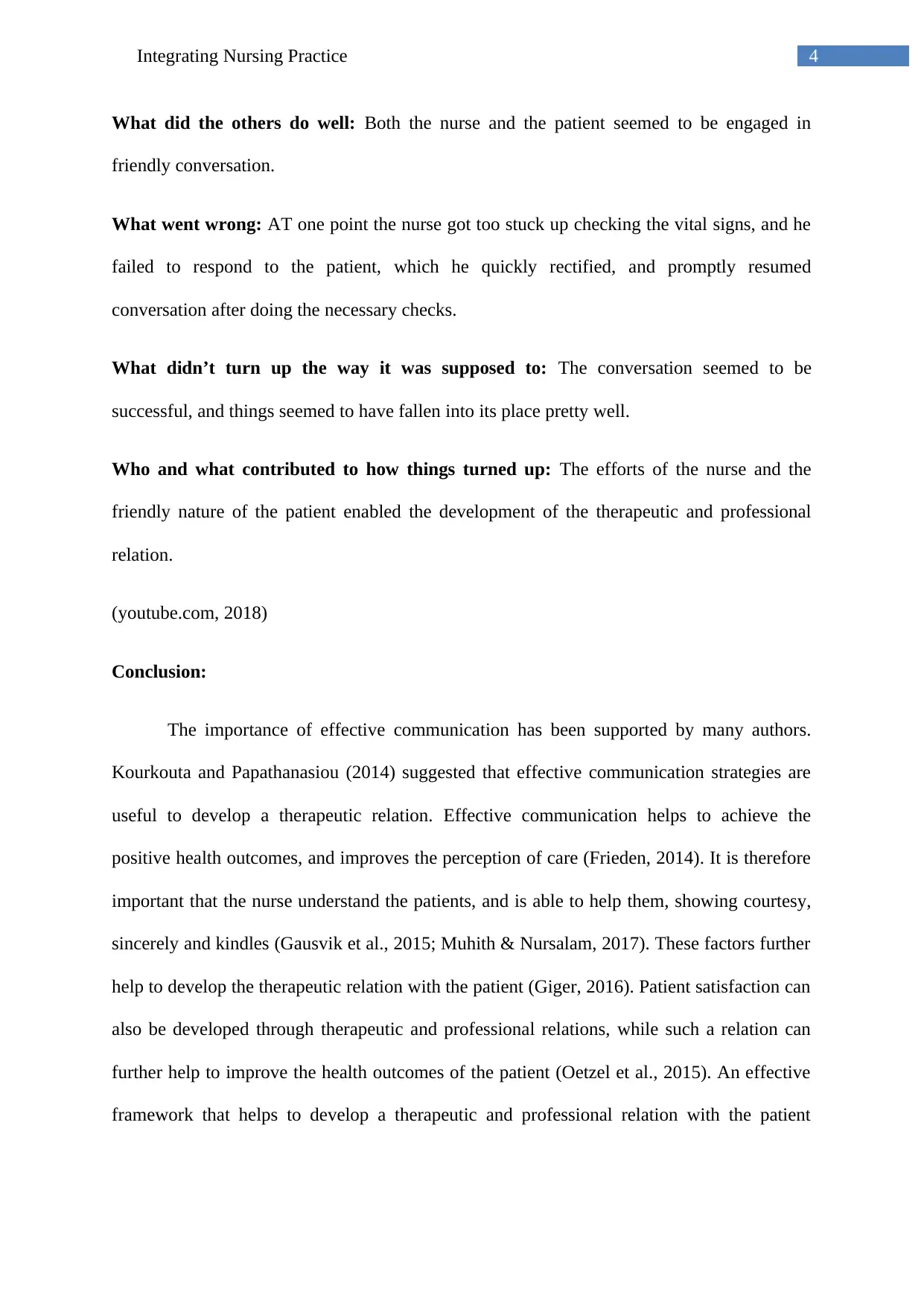
4Integrating Nursing Practice
What did the others do well: Both the nurse and the patient seemed to be engaged in
friendly conversation.
What went wrong: AT one point the nurse got too stuck up checking the vital signs, and he
failed to respond to the patient, which he quickly rectified, and promptly resumed
conversation after doing the necessary checks.
What didn’t turn up the way it was supposed to: The conversation seemed to be
successful, and things seemed to have fallen into its place pretty well.
Who and what contributed to how things turned up: The efforts of the nurse and the
friendly nature of the patient enabled the development of the therapeutic and professional
relation.
(youtube.com, 2018)
Conclusion:
The importance of effective communication has been supported by many authors.
Kourkouta and Papathanasiou (2014) suggested that effective communication strategies are
useful to develop a therapeutic relation. Effective communication helps to achieve the
positive health outcomes, and improves the perception of care (Frieden, 2014). It is therefore
important that the nurse understand the patients, and is able to help them, showing courtesy,
sincerely and kindles (Gausvik et al., 2015; Muhith & Nursalam, 2017). These factors further
help to develop the therapeutic relation with the patient (Giger, 2016). Patient satisfaction can
also be developed through therapeutic and professional relations, while such a relation can
further help to improve the health outcomes of the patient (Oetzel et al., 2015). An effective
framework that helps to develop a therapeutic and professional relation with the patient
What did the others do well: Both the nurse and the patient seemed to be engaged in
friendly conversation.
What went wrong: AT one point the nurse got too stuck up checking the vital signs, and he
failed to respond to the patient, which he quickly rectified, and promptly resumed
conversation after doing the necessary checks.
What didn’t turn up the way it was supposed to: The conversation seemed to be
successful, and things seemed to have fallen into its place pretty well.
Who and what contributed to how things turned up: The efforts of the nurse and the
friendly nature of the patient enabled the development of the therapeutic and professional
relation.
(youtube.com, 2018)
Conclusion:
The importance of effective communication has been supported by many authors.
Kourkouta and Papathanasiou (2014) suggested that effective communication strategies are
useful to develop a therapeutic relation. Effective communication helps to achieve the
positive health outcomes, and improves the perception of care (Frieden, 2014). It is therefore
important that the nurse understand the patients, and is able to help them, showing courtesy,
sincerely and kindles (Gausvik et al., 2015; Muhith & Nursalam, 2017). These factors further
help to develop the therapeutic relation with the patient (Giger, 2016). Patient satisfaction can
also be developed through therapeutic and professional relations, while such a relation can
further help to improve the health outcomes of the patient (Oetzel et al., 2015). An effective
framework that helps to develop a therapeutic and professional relation with the patient
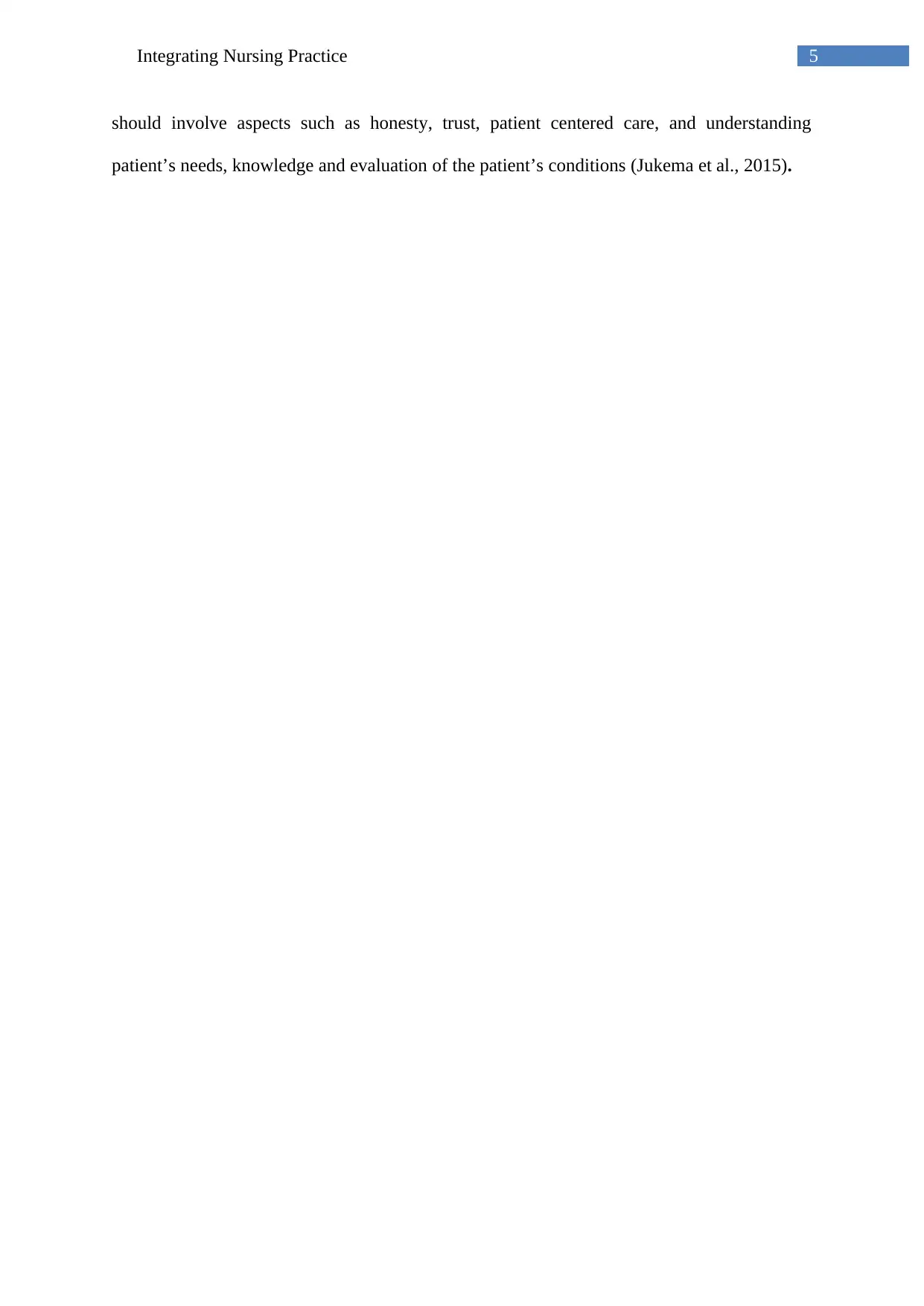
5Integrating Nursing Practice
should involve aspects such as honesty, trust, patient centered care, and understanding
patient’s needs, knowledge and evaluation of the patient’s conditions (Jukema et al., 2015).
should involve aspects such as honesty, trust, patient centered care, and understanding
patient’s needs, knowledge and evaluation of the patient’s conditions (Jukema et al., 2015).
⊘ This is a preview!⊘
Do you want full access?
Subscribe today to unlock all pages.

Trusted by 1+ million students worldwide
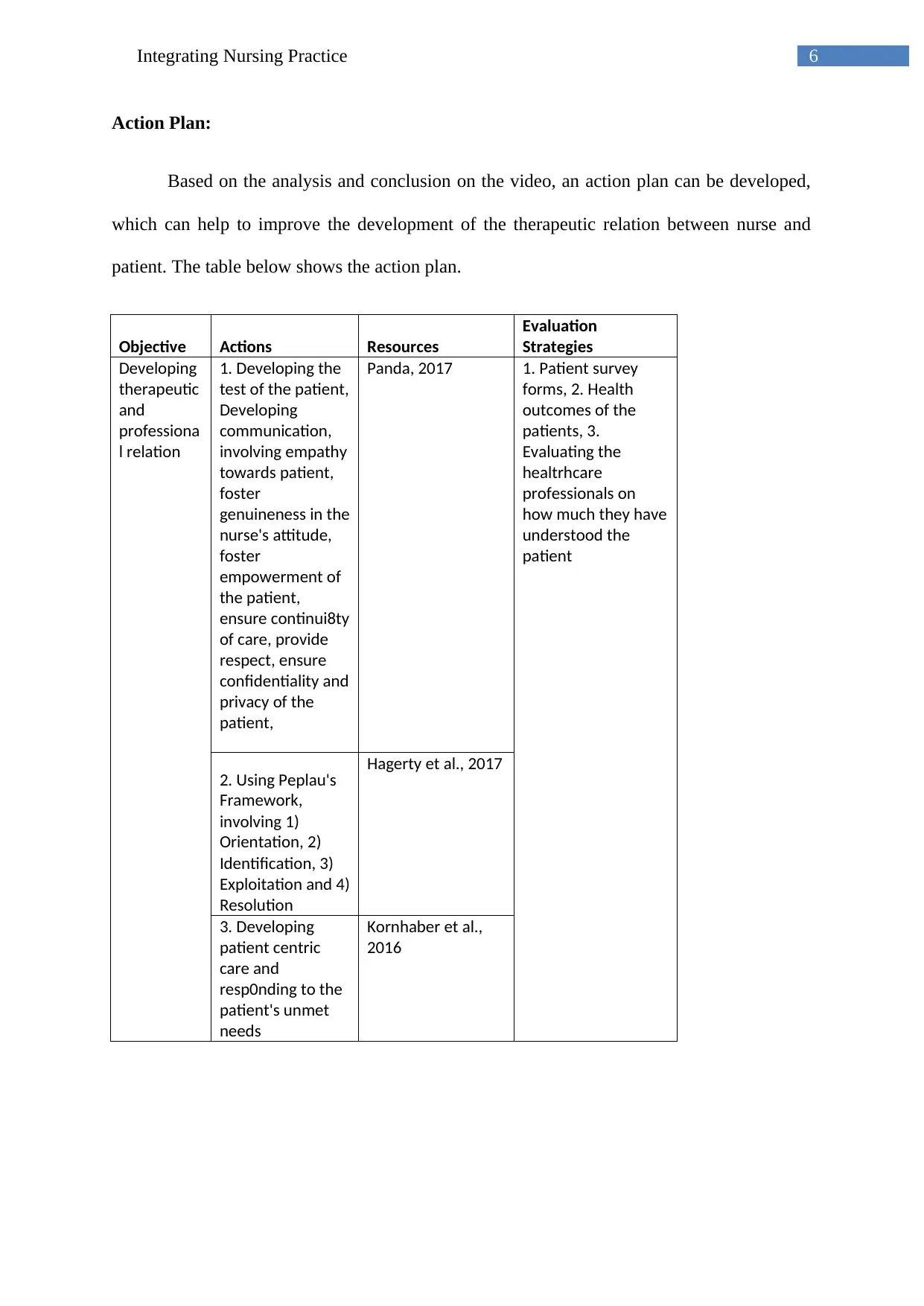
6Integrating Nursing Practice
Action Plan:
Based on the analysis and conclusion on the video, an action plan can be developed,
which can help to improve the development of the therapeutic relation between nurse and
patient. The table below shows the action plan.
Objective Actions Resources
Evaluation
Strategies
Developing
therapeutic
and
professiona
l relation
1. Developing the
test of the patient,
Developing
communication,
involving empathy
towards patient,
foster
genuineness in the
nurse's attitude,
foster
empowerment of
the patient,
ensure continui8ty
of care, provide
respect, ensure
confidentiality and
privacy of the
patient,
Panda, 2017 1. Patient survey
forms, 2. Health
outcomes of the
patients, 3.
Evaluating the
healtrhcare
professionals on
how much they have
understood the
patient
2. Using Peplau's
Framework,
involving 1)
Orientation, 2)
Identification, 3)
Exploitation and 4)
Resolution
Hagerty et al., 2017
3. Developing
patient centric
care and
resp0nding to the
patient's unmet
needs
Kornhaber et al.,
2016
Action Plan:
Based on the analysis and conclusion on the video, an action plan can be developed,
which can help to improve the development of the therapeutic relation between nurse and
patient. The table below shows the action plan.
Objective Actions Resources
Evaluation
Strategies
Developing
therapeutic
and
professiona
l relation
1. Developing the
test of the patient,
Developing
communication,
involving empathy
towards patient,
foster
genuineness in the
nurse's attitude,
foster
empowerment of
the patient,
ensure continui8ty
of care, provide
respect, ensure
confidentiality and
privacy of the
patient,
Panda, 2017 1. Patient survey
forms, 2. Health
outcomes of the
patients, 3.
Evaluating the
healtrhcare
professionals on
how much they have
understood the
patient
2. Using Peplau's
Framework,
involving 1)
Orientation, 2)
Identification, 3)
Exploitation and 4)
Resolution
Hagerty et al., 2017
3. Developing
patient centric
care and
resp0nding to the
patient's unmet
needs
Kornhaber et al.,
2016
Paraphrase This Document
Need a fresh take? Get an instant paraphrase of this document with our AI Paraphraser
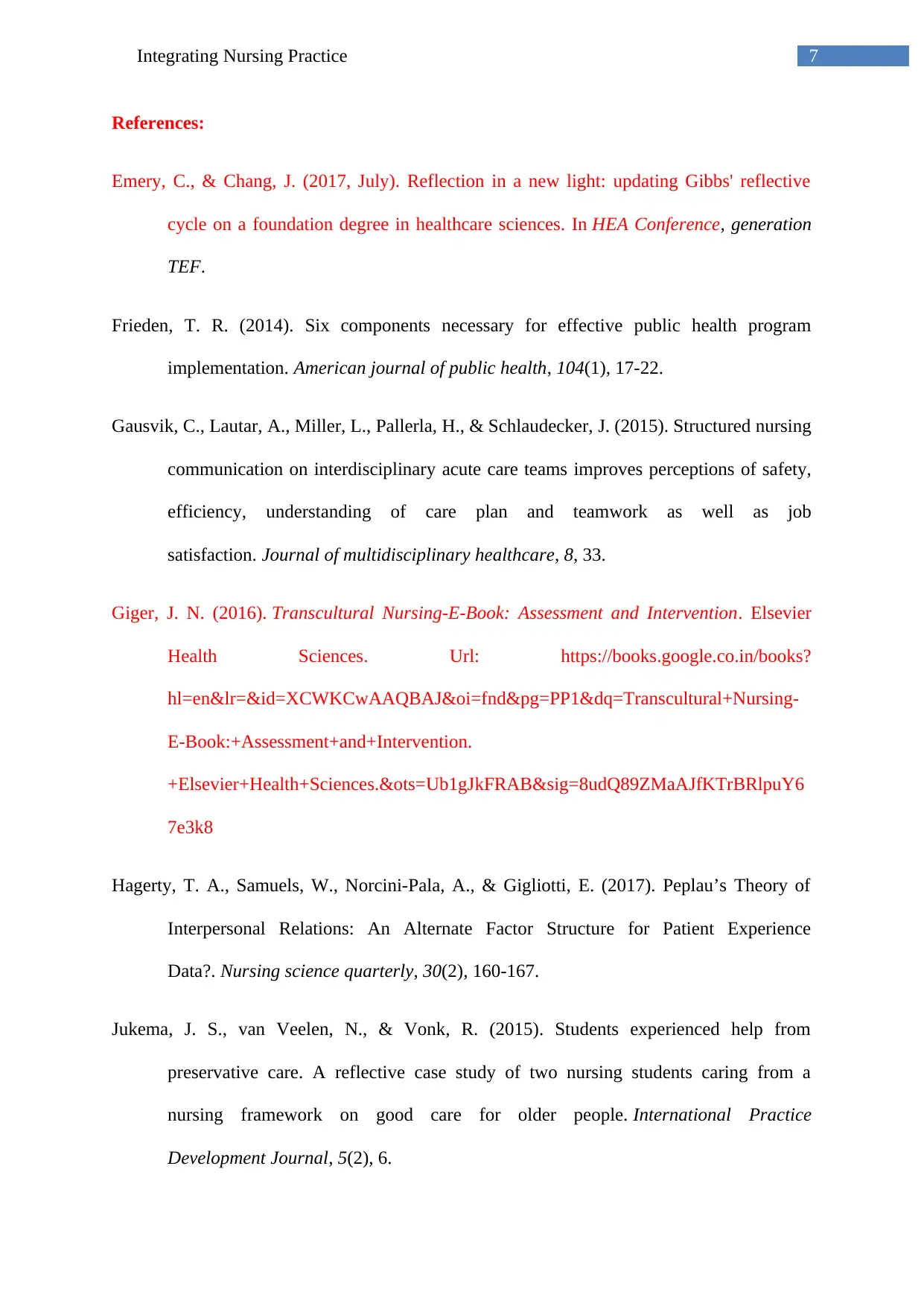
7Integrating Nursing Practice
References:
Emery, C., & Chang, J. (2017, July). Reflection in a new light: updating Gibbs' reflective
cycle on a foundation degree in healthcare sciences. In HEA Conference, generation
TEF.
Frieden, T. R. (2014). Six components necessary for effective public health program
implementation. American journal of public health, 104(1), 17-22.
Gausvik, C., Lautar, A., Miller, L., Pallerla, H., & Schlaudecker, J. (2015). Structured nursing
communication on interdisciplinary acute care teams improves perceptions of safety,
efficiency, understanding of care plan and teamwork as well as job
satisfaction. Journal of multidisciplinary healthcare, 8, 33.
Giger, J. N. (2016). Transcultural Nursing-E-Book: Assessment and Intervention. Elsevier
Health Sciences. Url: https://books.google.co.in/books?
hl=en&lr=&id=XCWKCwAAQBAJ&oi=fnd&pg=PP1&dq=Transcultural+Nursing-
E-Book:+Assessment+and+Intervention.
+Elsevier+Health+Sciences.&ots=Ub1gJkFRAB&sig=8udQ89ZMaAJfKTrBRlpuY6
7e3k8
Hagerty, T. A., Samuels, W., Norcini-Pala, A., & Gigliotti, E. (2017). Peplau’s Theory of
Interpersonal Relations: An Alternate Factor Structure for Patient Experience
Data?. Nursing science quarterly, 30(2), 160-167.
Jukema, J. S., van Veelen, N., & Vonk, R. (2015). Students experienced help from
preservative care. A reflective case study of two nursing students caring from a
nursing framework on good care for older people. International Practice
Development Journal, 5(2), 6.
References:
Emery, C., & Chang, J. (2017, July). Reflection in a new light: updating Gibbs' reflective
cycle on a foundation degree in healthcare sciences. In HEA Conference, generation
TEF.
Frieden, T. R. (2014). Six components necessary for effective public health program
implementation. American journal of public health, 104(1), 17-22.
Gausvik, C., Lautar, A., Miller, L., Pallerla, H., & Schlaudecker, J. (2015). Structured nursing
communication on interdisciplinary acute care teams improves perceptions of safety,
efficiency, understanding of care plan and teamwork as well as job
satisfaction. Journal of multidisciplinary healthcare, 8, 33.
Giger, J. N. (2016). Transcultural Nursing-E-Book: Assessment and Intervention. Elsevier
Health Sciences. Url: https://books.google.co.in/books?
hl=en&lr=&id=XCWKCwAAQBAJ&oi=fnd&pg=PP1&dq=Transcultural+Nursing-
E-Book:+Assessment+and+Intervention.
+Elsevier+Health+Sciences.&ots=Ub1gJkFRAB&sig=8udQ89ZMaAJfKTrBRlpuY6
7e3k8
Hagerty, T. A., Samuels, W., Norcini-Pala, A., & Gigliotti, E. (2017). Peplau’s Theory of
Interpersonal Relations: An Alternate Factor Structure for Patient Experience
Data?. Nursing science quarterly, 30(2), 160-167.
Jukema, J. S., van Veelen, N., & Vonk, R. (2015). Students experienced help from
preservative care. A reflective case study of two nursing students caring from a
nursing framework on good care for older people. International Practice
Development Journal, 5(2), 6.
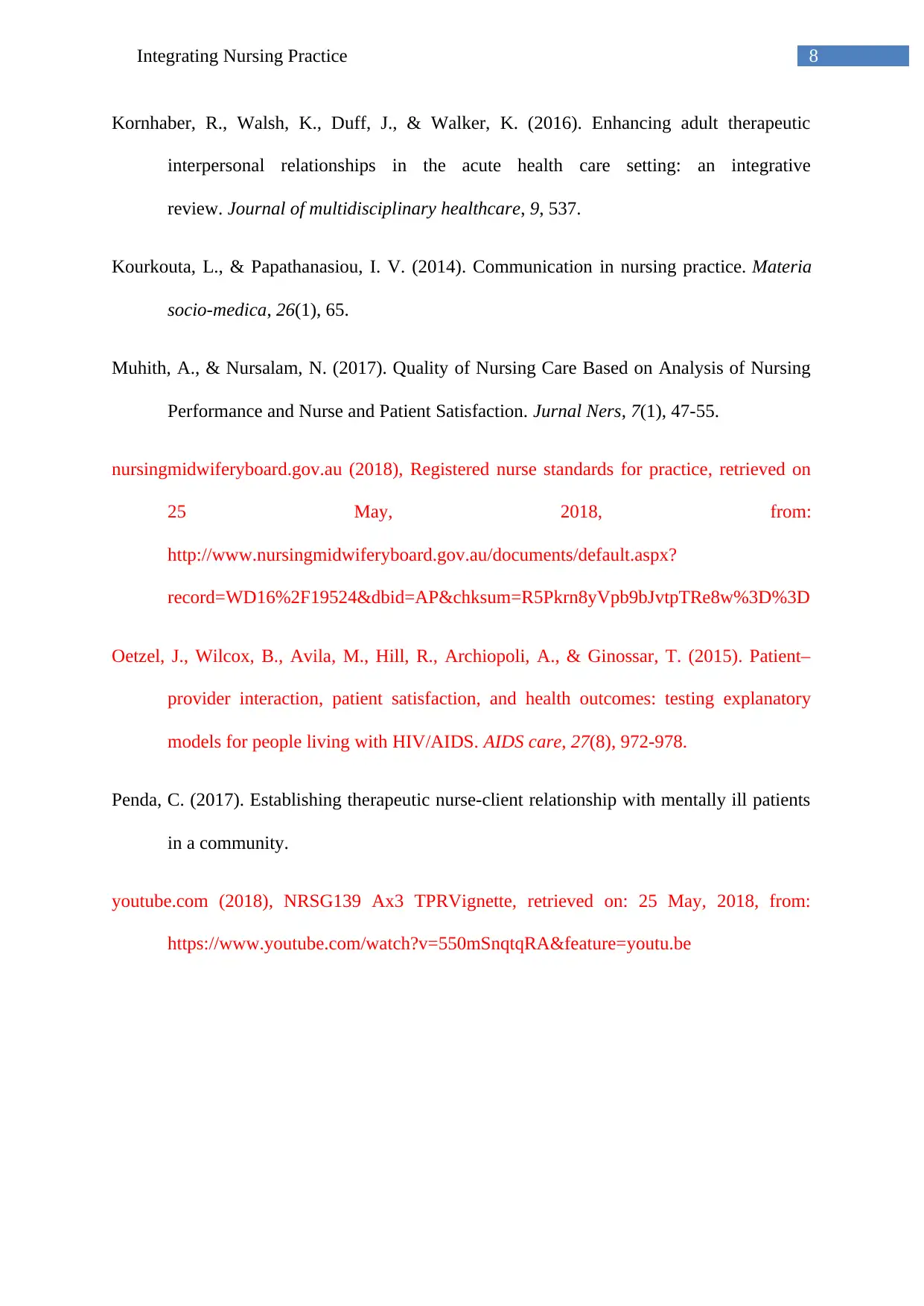
8Integrating Nursing Practice
Kornhaber, R., Walsh, K., Duff, J., & Walker, K. (2016). Enhancing adult therapeutic
interpersonal relationships in the acute health care setting: an integrative
review. Journal of multidisciplinary healthcare, 9, 537.
Kourkouta, L., & Papathanasiou, I. V. (2014). Communication in nursing practice. Materia
socio-medica, 26(1), 65.
Muhith, A., & Nursalam, N. (2017). Quality of Nursing Care Based on Analysis of Nursing
Performance and Nurse and Patient Satisfaction. Jurnal Ners, 7(1), 47-55.
nursingmidwiferyboard.gov.au (2018), Registered nurse standards for practice, retrieved on
25 May, 2018, from:
http://www.nursingmidwiferyboard.gov.au/documents/default.aspx?
record=WD16%2F19524&dbid=AP&chksum=R5Pkrn8yVpb9bJvtpTRe8w%3D%3D
Oetzel, J., Wilcox, B., Avila, M., Hill, R., Archiopoli, A., & Ginossar, T. (2015). Patient–
provider interaction, patient satisfaction, and health outcomes: testing explanatory
models for people living with HIV/AIDS. AIDS care, 27(8), 972-978.
Penda, C. (2017). Establishing therapeutic nurse-client relationship with mentally ill patients
in a community.
youtube.com (2018), NRSG139 Ax3 TPRVignette, retrieved on: 25 May, 2018, from:
https://www.youtube.com/watch?v=550mSnqtqRA&feature=youtu.be
Kornhaber, R., Walsh, K., Duff, J., & Walker, K. (2016). Enhancing adult therapeutic
interpersonal relationships in the acute health care setting: an integrative
review. Journal of multidisciplinary healthcare, 9, 537.
Kourkouta, L., & Papathanasiou, I. V. (2014). Communication in nursing practice. Materia
socio-medica, 26(1), 65.
Muhith, A., & Nursalam, N. (2017). Quality of Nursing Care Based on Analysis of Nursing
Performance and Nurse and Patient Satisfaction. Jurnal Ners, 7(1), 47-55.
nursingmidwiferyboard.gov.au (2018), Registered nurse standards for practice, retrieved on
25 May, 2018, from:
http://www.nursingmidwiferyboard.gov.au/documents/default.aspx?
record=WD16%2F19524&dbid=AP&chksum=R5Pkrn8yVpb9bJvtpTRe8w%3D%3D
Oetzel, J., Wilcox, B., Avila, M., Hill, R., Archiopoli, A., & Ginossar, T. (2015). Patient–
provider interaction, patient satisfaction, and health outcomes: testing explanatory
models for people living with HIV/AIDS. AIDS care, 27(8), 972-978.
Penda, C. (2017). Establishing therapeutic nurse-client relationship with mentally ill patients
in a community.
youtube.com (2018), NRSG139 Ax3 TPRVignette, retrieved on: 25 May, 2018, from:
https://www.youtube.com/watch?v=550mSnqtqRA&feature=youtu.be
⊘ This is a preview!⊘
Do you want full access?
Subscribe today to unlock all pages.

Trusted by 1+ million students worldwide

9Integrating Nursing Practice
1 out of 10
Related Documents
Your All-in-One AI-Powered Toolkit for Academic Success.
+13062052269
info@desklib.com
Available 24*7 on WhatsApp / Email
![[object Object]](/_next/static/media/star-bottom.7253800d.svg)
Unlock your academic potential
Copyright © 2020–2025 A2Z Services. All Rights Reserved. Developed and managed by ZUCOL.




